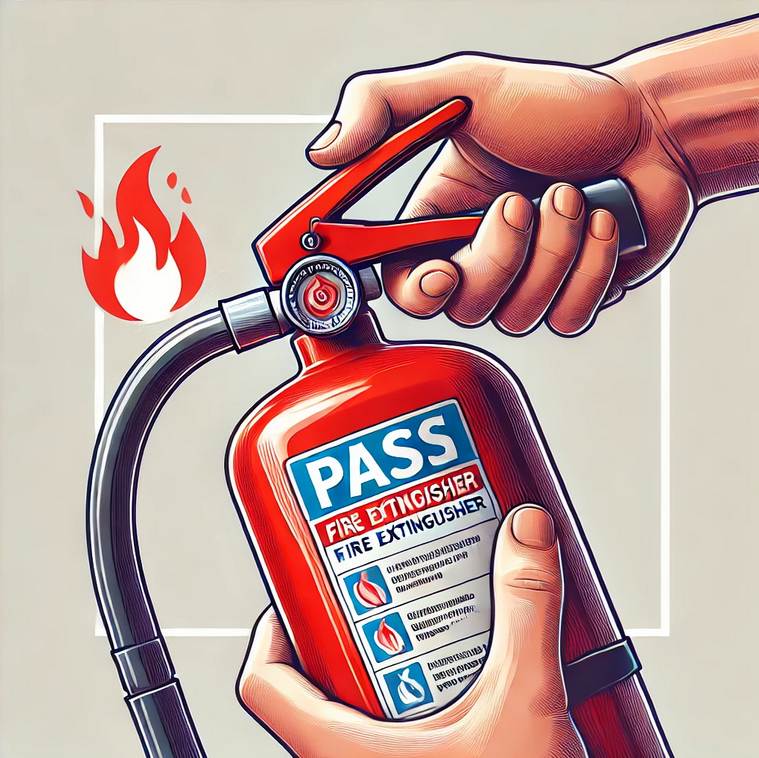Fire extinguishers are essential safety tools designed to combat small fires before they escalate into larger, uncontrollable emergencies.
However, owning or having access to a fire extinguisher isn’t enough; knowing how to use it correctly can make all the difference in a critical moment.
This is where the PASS technique comes into play—a simple, four-step process that ensures you can operate a fire extinguisher effectively and safely.
What Does PASS Stand For?
The acronym PASS stands for:
- Pull the Pin
- Aim the Nozzle
- Squeeze the Handle
- Sweep from Side to Side
Each step is critical in using a fire extinguisher correctly and minimizing the risks involved in putting out a fire.
Step-by-Step Breakdown of PASS
1. Pull the Pin
The first step in using a fire extinguisher is to release the locking mechanism by pulling the pin. The pin is located in the handle and is designed to prevent accidental discharge. Pulling it ensures that the extinguisher is ready for use. Always hold the extinguisher upright during this step for proper handling.
Tip: Keep the pin in your hand or pocket while extinguishing the fire. It may be needed later for reassembly or disposal.
2. Aim the Nozzle
Once the pin is removed, point the extinguisher’s nozzle or hose at the base of the fire. It’s vital to aim low because the source of the fire—where the fuel and heat combine—is at the base. Attacking the flames directly may look effective, but it won’t extinguish the fire unless the fuel is cooled or removed.
Safety Note: Stand at a safe distance (approximately 6-10 feet away) while aiming the extinguisher.
3. Squeeze the Handle
Firmly squeeze the handle to release the extinguishing agent. This step requires consistent pressure to ensure a steady stream of the extinguishing material. The release mechanism can sometimes feel stiff, so apply enough force to activate the extinguisher.
Caution: Be aware of the extinguisher’s recoil. Hold it tightly to maintain control, especially for larger extinguishers.
4. Sweep from Side to Side
Finally, move the nozzle or hose in a sweeping motion from side to side while continuing to aim at the base of the fire. This ensures the extinguishing agent covers the entire fire area and prevents re-ignition. Continue sweeping until the fire appears to be out and monitor the area for any signs of rekindling.
Pro Tip: Even after the flames subside, keep spraying for a few extra seconds to ensure the fire is fully extinguished.
When to Use the PASS Technique
The PASS technique is suitable for small, manageable fires, such as those involving flammable liquids, electrical equipment, or combustible materials. It’s not intended for large, rapidly spreading fires, which should be left to professional firefighters.

Assess Before Acting:
- Size of the Fire: If the fire is larger than a small trash can, evacuate and call emergency services immediately.
- Escape Route: Ensure you have a clear exit path before attempting to extinguish the fire.
- Fire Extinguisher Type: Use the correct extinguisher for the fire class (A, B, C, D, or K). For example, use a Class B extinguisher for flammable liquids and a Class C extinguisher for electrical fires.
Importance of Fire Safety Training
While the PASS technique is simple, proper training is crucial to ensure that everyone in your home or workplace knows how to use a fire extinguisher. Regular fire drills and hands-on training sessions can help individuals feel more confident and prepared in emergency situations.
Resources for Training
- Local Fire Departments: Many offer free fire safety training sessions.
- Safety Organizations: Groups like National Fire Protection Association (NFPA) provide valuable resources.
- Online Courses: Interactive training programs can teach extinguisher use and fire prevention strategies.
Fire Extinguisher Maintenance
A properly maintained fire extinguisher is as important as knowing how to use it. Ensure that extinguishers are inspected regularly for:
- Pressure Levels: Check the gauge to ensure it’s in the “green” zone.
- Physical Damage: Look for rust, dents, or leaks.
- Accessibility: Extinguishers should be mounted in visible and easily accessible locations.
Most fire extinguishers have a lifespan of 5 to 15 years, depending on the type and manufacturer. Replace or service them as recommended.

The PASS technique is a lifesaving method that empowers individuals to act swiftly and confidently during a fire emergency. By learning to Pull, Aim, Squeeze, and Sweep, you can effectively tackle small fires and potentially save lives and property.
However, it’s equally important to recognize your limits and call for professional help when needed. Fire safety is everyone’s responsibility, and understanding the PASS method is a crucial first step in fostering a safer environment.
For more fire safety tips, explore resources like NFPA.org or OHSE.ca, and remember: Preparation saves lives.

No comments yet